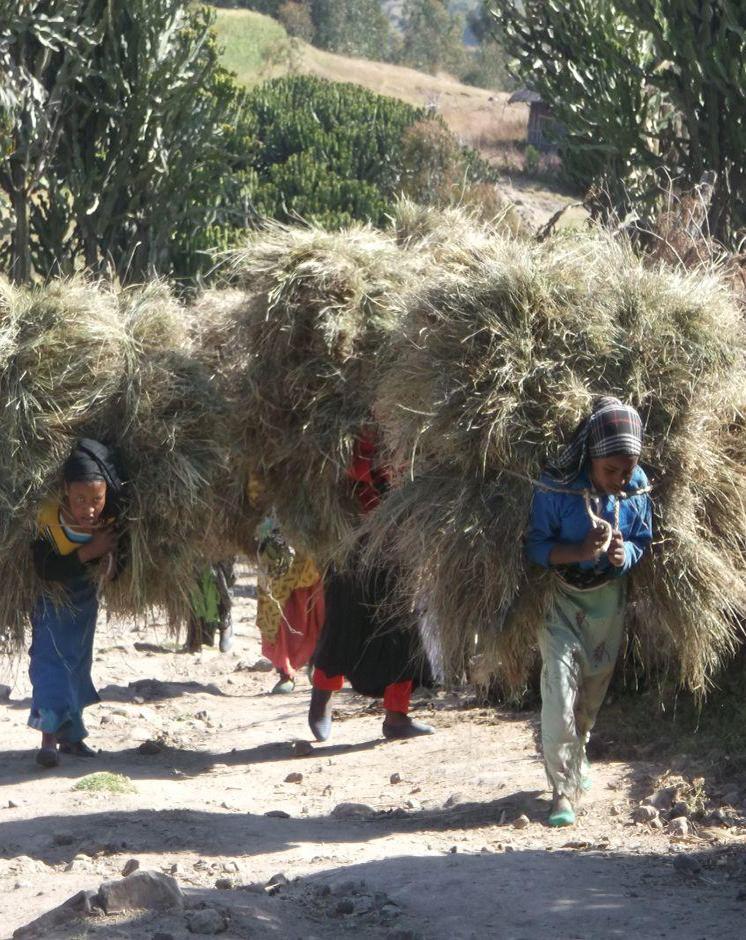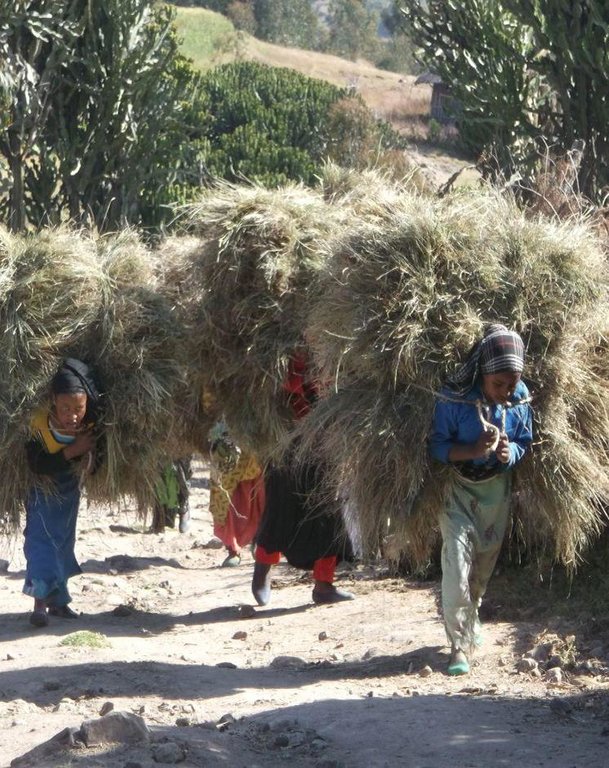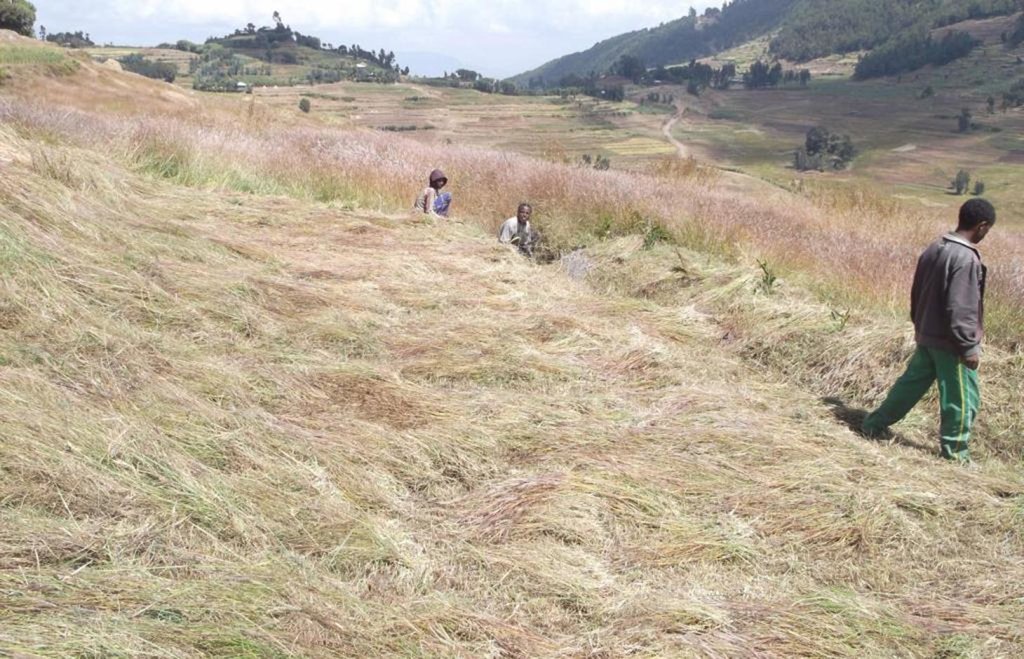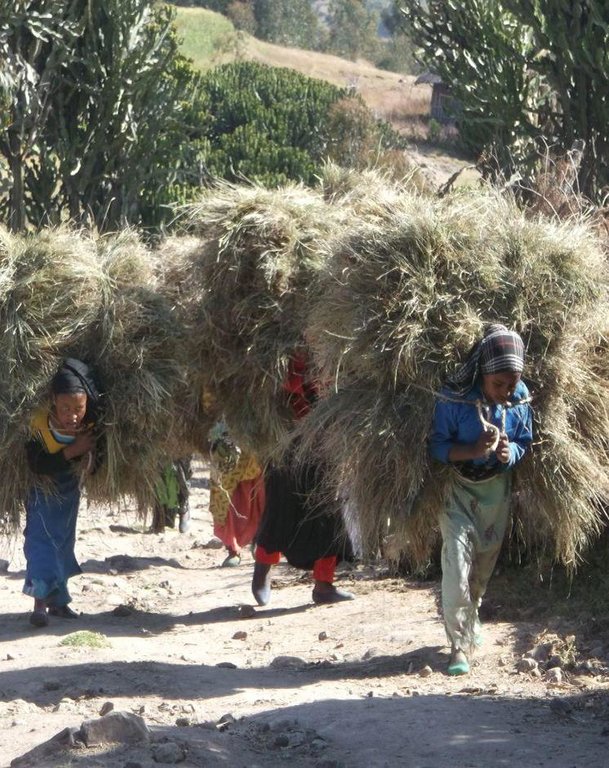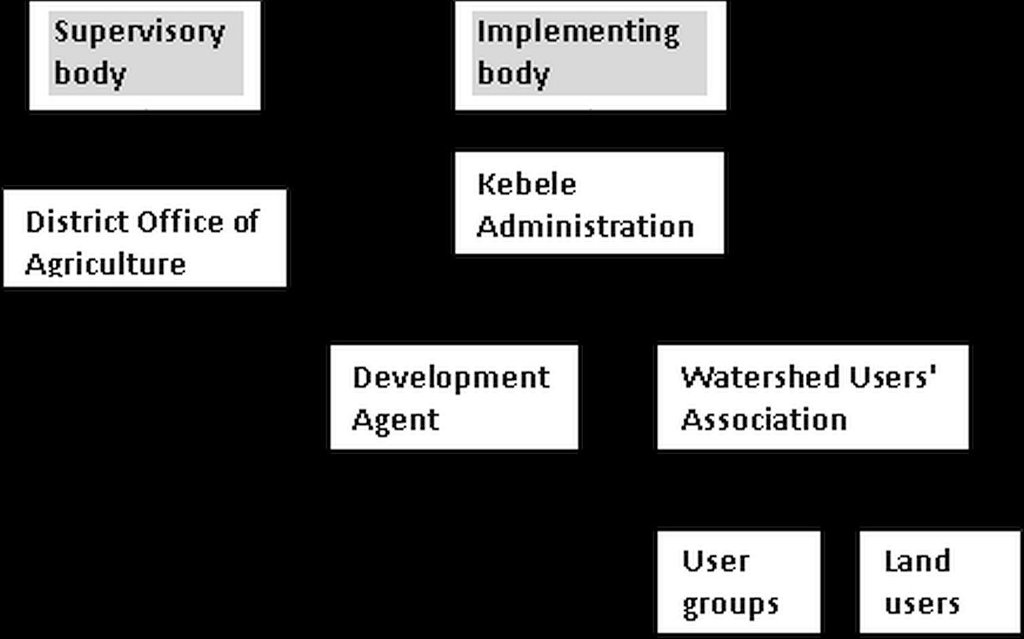'Cut and Carry' Grazing system or 'Zero Grazing' (CCG) [Etiopía]
- Creación:
- Actualización:
- Compilador: Gizaw Desta Gessesse
- Editor: –
- Revisor: Fabian Ottiger
Ensesa Asro Memgeb (Amharic)
approaches_2497 - Etiopía
Visualizar secciones
Expandir todo Colapsar todos1. Información general
1.2 Detalles de contacto de las personas de referencia e instituciones involucradas en la evaluación y la documentación del Enfoque
Especialista MST:
Melese Bekure
WLRC
Etiopía
Nombre de la(s) institución(es) que facilitaron la documentación/ evaluación del Enfoque si fuera relevante)
Water and Land Resource Centre (WLRC) - Etiopía1.3 Condiciones referidas al uso de datos documentados mediante WOCAT
¿Cuándo se compilaron los datos (en el campo)?
16/05/2014
El compilador y la/s persona(s) de referencia claves aceptan las condiciones acerca del uso de los datos documentados mediante WOCAT :
Sí
1.4 Referencia/s al/los Cuestionario(s) de Tecnologías MST
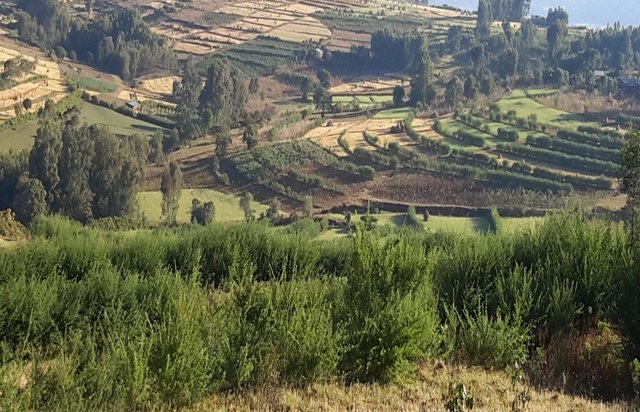
Vegetated graded soil bund [Etiopía]
Vegetated graded soil bund is a soil conservation practice meant for cultivated lands and constructed by excavating graded channel on upper side and develop embankment on lower side which is planted with grass or shrub species in order to control soil erosion and drain excess runoff implemented through community mobilization.
- Compilador: Gizaw Desta Gessesse
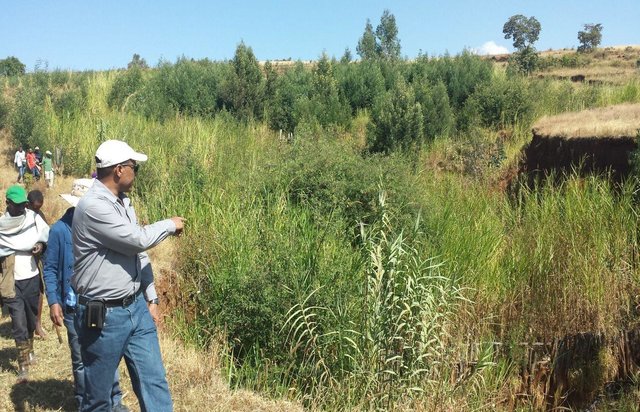
Gully erosion management [Etiopía]
Gully erosion management is the application of combination of practices to control excess or concentrated runoff generation in the gully upstream catchment area, divert excess runoff upstream of gully heads and control further development of gully using appropriate structural and vegetative measures in the head, bed and sides of the …
- Compilador: Gizaw Desta Gessesse
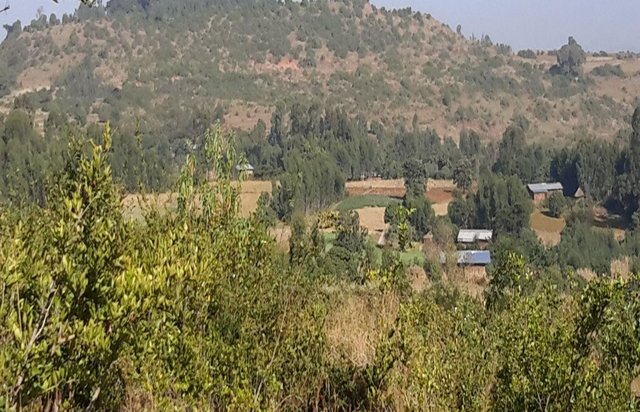
Area closure on degraded lands [Etiopía]
Area closure on degraded lands is a land management practice used to rehabilitate and conserve the natural resource bases, and enhance its natural regeneration and restoring capacity and productive functions by excluding animal and human interferences through community consultation and collective actions.
- Compilador: Gizaw Desta Gessesse
2. Descripción del Enfoque MST
2.1 Breve descripción del Enfoque
Cut and carry grazing system (alternatively called zero grazing) is an approach where the community is consulted to identify and agree on areas to be closed and protected from free grazing; establish user groups are established to share the fodder biomass harvested from communal closed areas equitably; they utilize tree/shrub fodder planted on bunds.
2.2 Descripción detallada del Enfoque MST
Descripción detallada del Enfoque MST:
Aims / objectives: Zero grazing aims to reduce the impact of livestock management on land degradation. The objectives are: 1) implement cut and carry grazing system by establishing user groups for equitable share of biomass, 2) increase forage quantity and quality by improving the fodder and grass biomass production per unit area, 3) Protect further soil degradation and vegetation loss
Methods: Cut and carry employs series discussion with community to identify zero grazing sites and set bylaws to implement the approach. The watershed committee together with Development Agents and Kebele administration consult the community to identify and decide on the right beneficiaries of benefits gained from closed communal areas. Once the community agrees on the bylaws, the Kebele unit council approved and passed to district court for endorsement. The watershed committee, now renamed as Watershed Users Association, is the legitimate body authorized to regulate watershed management and benefit sharing among entitled users. The money collected from penalty fee from those who violate the rules use as a revolving fund to be used for other watershed development activities. The beneficiaries organize themselves into groups and they divided the benefits on equaitable basis at every harvest season. The users keep their animals around homes or sheds and feed them on harvested fodder/grass.
Stages of implementation: 1. Consultation and discussion with community in order to identify areas free from livestock access, formulate bylaws, control free grazing, and protect the developed watersheds from livestock interference,
2. Identification and organization of right beneficiaries into user groups who actually used to benefit previously on the selected area and new users that are believed to share the benefit,
3. Undertaking treatment of area closures with biological, structural and land use management measures as well as planting bunds on crop lands with fodder and grass species,
4. Watershed Committee start to implement or enforce the agreed bylaws on those who violate the rules (allow livestock in the protected areas, harvest biomass or cut tree from closed areas by untitled users, etc.),
5. Utilization of the biomass by user group members through equal share of the harvested biomass.
Role of stakeholders: Community: The community was responsible to select closed areas from livestock interference, identify beneficiaries, harvest and utilize the biomass as per the agreement, and respect and comply with the rules/bylaws;
Development agents: Supported the watershed committee in regulating protected areas, provide technical advice in the implementing integrated watershed interventions and subsequent maintenance activities or operations, and provide awareness creation and training about fodder utilization;
Watershed committee/watershed users association: It played the key role in planning, managing the developed watershed and regulate the benefit utilization arrangements. It applies the rules for those who do not comply with;
Kebele administration: The administration was responsible to control and manage the overall activities and supervise the implementation
Command post: Both the district and kebele command post (adhoc committee) is responsible to supervise the activities and solve problems;
Research: research involved to take part in introducing improved technologies that increase biomass production (like improved species with high quality and biomass) and efficiency (harvesting and packaging implements);
Project/WLRC: Provided material and technical support for the planning, implementation and monitoring activities.
Other important information: Cut and carry grazing system is an important intervention in the Ethiopian farming system where livestock and crop farming are mixed and livestock husbandry is means of crop production and household asset. Livestock farming is a subsistence production, which is not yet commercialized.
2.3 Fotos del Enfoque
2.5 País/ región/ lugares donde el Enfoque fue aplicado
País:
Etiopía
Región/ Estado/ Provincia:
Amhara National Regional State
Especifique más el lugar :
Bahir Dar Zuria, Mecha, Yilmna Densa, Dessie Zuria
2.6 Fechas de inicio y conclusión del Enfoque
Indique año del inicio:
2011
2.7 Tipo de Enfoque
- proyecto/ basado en un programa
2.8 Propósitos/ objetivos principales del Enfoque
The Approach focused on SLM only
The main objectives of cut and carry or zero grazing is protection of land degradation and loss of vegetation on communal lands and controlling damage on the soil and water conservation measures implemented on watersheds. Specifically, it is to practice cut and carry feeding system by establishing equitable share of biomass among user groups, increase quantity and quality of forage, and protect further degradation of land and loss of vegetation.
The SLM Approach addressed the following problems: The main problems targeted to address by implementing cut and carry or zero grazing approach are: growing challenges of land degradation due to overgrazing and compaction/trampling effects; growing shortage of livestock feed; lack of communal land resource management regulation and actions.
2.9 Condiciones que facilitan o impiden la implementación de la/s Tecnología/s aplicadas bajo el Enfoque
disponibilidad/ acceso a recursos y servicios financieros
- impiden
Inadequate diversification of income from livestock production due to its low carrying capacity of the grazing lands, low input and technology supply as well as low financial capacity of farmers
Treatment through the SLM Approach: Zero grazing approach helps to increase livestock productivity and attain better weight gain for market.
entorno institucional
- impiden
Lack of common property management and regulation to share benefits equitably among users. There is reluctance to respect local initiated bylaws to stop free grazing.
Treatment through the SLM Approach: Watershed committee is institutionalized to govern zero grazing implementation procedures and entitle use rights to right beneficiaries in a group.
marco de trabajo legal (tenencia de tierra, derechos de uso de tierra y agua)
- impiden
The existing land ownership, land use rights / water rights moderately hindered the approach implementation Since there is tradition of open access grazing (animals allowed to graze freely) and pasture lands are communally used, this tradition affects the sustainability of the approach. Although there are community bylaws attempted to enforce through the watershed committee, farmers not yet fully practice cut and carry system of grazing. This, because they wanted to maximize the benefit by entitling individual use rights for communal land resources.
conocimiento de MST, acceso a apoyo técnico
- impiden
Lack of immediate feed options and lack of knowledge of improved fodder production and forage utilization.
Low level of understanding about multiple advantages of zero grazing. Degradation of natural resources in the form of compaction, loss of organic matter and soil erosion and damage to grass and plant biodiversity.
Treatment through the SLM Approach: The approach support to build the skill and knowledge of users about the forage production and utilization techniques by research actors as well it enables to understand feed requirement per household.
3. Participación y roles de las partes interesadas involucradas
3.1 Partes interesadas involucradas en el Enfoque y sus roles
- usuarios locales de tierras/ comunidades locales
The watershed Users Association, kebele administration and development agents
Individual land users has to play role to control free grazing and practice zero grazing. The closed areas are owned in group and need to protect and control in group. The role of men was mainly dedicated to control free grazing activities and involved in harvesting forage. Women were involved in the plantation of vegetative measures, in bunds and area closures, they took care of animals around their homestead, sometimes they transported forage/biomass for livestock. The approach entitled those who do not own animals to share the biomass collected from communal closed areas. They earned cash by selling the biomass harvest for forage purpose.
- especialistas MST/consejeros agrícolas
They are involved in the planning, support and supervision of the implementation, monitoring and evaluating the implementation
- gobierno local
The district agriculture office
- gobierno nacional (planificadores, autoridades)
Decision makers
They play role to enforce the rules and mobilize the community to control free grazing
3.2 Involucramiento de los usuarios locales de tierras/ comunidades locales en las distintas fases del Enfoque
| Involucramiento de los usuarios locales de tierras/ comunidades locales | Especifique quién se involucró y describa las actividades | |
|---|---|---|
| iniciación/ motivación | ninguno | |
| planificación | interactivo | The community and individual land users agree to delineate areas closed from free grazing. At this stage land users should involve and agree. |
| implementación | interactivo | land users need to participate and involve actively to control free grazing and practice cut and carry feeding system. |
| monitoreo y evaluación | interactivo | Land users are involved in the evaluation and field days. |
| Research | interactivo | Land users are involved in participatory technology generation and promotion. |
3.3 Flujograma (si estuviera disponible)
Descripción:
The district office of agriculture together with its Kebele unit is the supervisory body for implementing cut and carry or zero grazing approach. The main implementers are the kebele administration, the watershed users' association and development agents. The Watershed Users' Association (WUA) or sometimes called watershed committee is the implementer of the daily activities or operations to manage and regulate developed watersheds and specifically zero grazing approach by enforcing the agreed bylaws. The Kebele administration unit support and manage administrative matters associated to zero grazing while the development agents assist the WUA and user groups on technical issues. User groups and land users are part of the implementation of the processes.
Autor:
Gesesse, Gizaw Desta (WLRC, P.O.Box 8707, Addis Abeba, Ethiopia)
3.4 La toma de decisiones en la selección de Tecnología(s) MST
Especifique quién decidió la selección de las Tecnología/ Tecnologías a implementarse:
- principalmente por especialistas MST en consulta con usuarios de tierras
Explique:
Decisions on the method of implementing the SLM Technology were made by mainly by SLM specialists with consultation of land users
4. Apoyo técnico, fortalecimiento institucional y gestión del conocimiento
4.1 Construcción de capacidades / capacitación
¿Se proporcionó la capacitación a usuarios de tierras/ otras partes interesadas?
Sí
Especifique quién fue capacitado:
- usuarios de tierras
- personal de campo/ consejeros
- leaders at local level
Si fuese relevante, también especifique género, edad, estatus, etnicidad, etc.
Awareness creation is provided to all land users both men and women, development staff and local leaders.
Forma de capacitación:
- de agricultor a agricultor
- áreas de demostración
- reuniones públicas
Temas avanzados:
Magnitude and extent of land degradation and the impact of livestock pressure on depletion of natural resources. The community was advised to reduce livestock number and to rely on small number of improved breeds supplemented with intensive forage production and treated crop residues. Development staff was involved in trainings about forage production and management. Leaders also took part in trainings and awareness workshops about land degradation and natural resources conservation.
4.2 Servicio de asesoría
¿Los usuarios de tierras tienen acceso a un servicio de asesoría?
Sí
Especifique si servicio proporcionado se realizó:
- en centros permanentes
Describa/ comentarios:
Name of method used for advisory service: Participatory Demonstration and Training Extension System (PADETES); Key elements: Training and awareness creation of farmers in Farmer Training Centers (FTC), Provision of inputs and package, and demonstrations on the Farmer Training Centers (FTC) and experience sharing visits, On job training; The method gives high emphasis to training and to some extent practical demonstrations supported with experience
sharing visits but less emphasis to advisory of farmers on site.
Advisory service is quite adequate to ensure the continuation of land conservation activities; The extension system is quite adequate to ensure continuation of activities. The government service is adequate to ensure the implementation. Furthermore, if the newly structured and formulated Watershed Users Association functions well, it is sufficient to regulate the approach and sustain land conservation.
4.3 Fortalecimiento institucional (desarrollo institucional)
¿Se establecieron o fortalecieron instituciones mediante el Enfoque?
- sí, moderadamente
Especifique el nivel o los niveles en los que se fortalecieron o establecieron las instituciones:
- local
Especifique el tipo de apoyo:
- construcción de capacidades/ entrenamiento
Proporcione detalles adicionales:
The support is mainly awareness creation and training. The local institutions like watershed users association, User Groups, Farmer Training Centers are supported by training.
4.4 Monitoreo y evaluación
¿El monitoreo y la evaluación forman parte del Enfoque?
Sí
Comentarios:
bio-physical aspects were ad hoc monitored by project staff, government, land users through observations; indicators: Free grazing by animals; land users who practice zero grazing
bio-physical aspects were regular monitored by project staff through measurements; indicators: Forage biomass harvested and shared among the land users
technical aspects were ad hoc monitored by project staff, government, land users through observations; indicators: Fattening practice; change in animal body performance
socio-cultural aspects were ad hoc monitored by project staff through observations; indicators: Formation of User Groups and share of benefits; Conflict reduction; role of actors
economic / production aspects were ad hoc monitored by project staff, government through observations; indicators: Fattening benefits;
area treated aspects were ad hoc monitored by project staff through observations; indicators: Area covered by zero grazing
no. of land users involved aspects were ad hoc monitored by project staff, land users through observations; indicators: Land users who practice zero grazing or who voilate the rules
management of Approach aspects were regular monitored by None through measurements; indicators: Damage to treated areas by free grazing
There were several changes in the Approach as a result of monitoring and evaluation: As a result of monitoring and evaluation the practice of zero grazing is expanded. Strict enforcement of the bylaws brought change in zero grazing practices and some also attempted to reduce their livestock number
There were no changes in the Technology as a result of monitoring and evaluation
4.5 Investigación
¿La investigación formó parte del Enfoque?
Sí
Especifique los temas:
- ecología
- tecnología
Proporcione detalles adicionales e indique quién hizo la investigación:
The research support is most of the time in form of on-farm research. Research is part of the approach. The research provides technical backstopping by introducing improved agricultural technologies like improved forage species and breeds that complement the SLM technologies where the approach is designed for.
Research was carried out on-farm
5. Financiamiento y apoyo material externo
5.1 Presupuesto anual para el componente MST del Enfoque
Si no se conoce el presupuesto anual preciso, indique el rango:
- 10,000-100,000
Comentarios (ej. fuentes principales de financiamiento/ donantes principales):
Approach costs were met by the following donors: local government (district, county, municipality, village etc) (Through technical and material support and capacity building): 28.0%; local community / land user(s) (For scouting by Watershed Users Association, free labor for implementation, and sometimes wage for guards): 72.0%
5.2 Apoyo financiero/material proporcionado a los usuarios de tierras
¿Los usuarios de tierras recibieron financiamiento/ apoyo material para implementar la Tecnología/ Tecnologías? :
Sí
Si respondió sí, especifique el tipo o los tipos de apoyo, condiciones y proveedor(es) :
The inputs like seedlings and grass splits raised in the nurseries for the implementation of vegetative measures and other technologies that support the efficiency and management of the SLM technologies are supported by the government and/or projects.
5.3 Subsidios para insumos específicos (incluyendo mano de obra)
- equipo
| Especifique qué insumos se subsidiaron | En qué grado | Especifique los subsidios |
|---|---|---|
| herramientas | parcialmente financiado | Hand tools for construction |
- agrícola
| Especifique qué insumos se subsidiaron | En qué grado | Especifique los subsidios |
|---|---|---|
| semillas | totalmente financiado | Tree seedlings and grasses |
Si la mano de obra de usuarios de tierras fue un insumo sustancial, ¿fue:
- voluntario?
Comentarios:
The labor is totally contributed by land users voluntarily through community mobilization approach.
5.4 Crédito
¿Se proporcionó crédito bajo el Enfoque para actividades MST?
No
6. Análisis de impacto y comentarios de conclusión
6.1 Impactos del Enfoque
¿El Enfoque ayudó a los usuarios de tierras a implementar y mantener Tecnologías MST?
- No
- Sí, un poco
- Sí, moderadamente
- Sí, mucho
The approach aim to rehabilitate unproductive and degraded lands and thereby the soil moisture and biomass productivity improve. It also helps to increase the level of awareness to protect and manage communal resources and share of benefits out of it. It also gradually increases the ecosystem services such as increase the duration of flow of streams, increase stream flow and water availability, improve the diversity of plant species, and improve the micro-climatic conditions.
¿El Enfoque empoderó a grupos en desventaja social y económica?
- No
- Sí, un poco
- Sí, moderadamente
- Sí, mucho
Land users who do not have animals also share the benefit equally with the land users who own animals. Thus, they improve their situation by selling grass biomass for feed. Others also employed to prepare and raise tree and grass seedlings in nurseries.
¿El Enfoque mejoró cuestiones de tenencia de tierra/ derechos de usuarios que obstaculizaron la implementación de la Tecnologías MST?
- No
- Sí, un poco
- Sí, moderadamente
- Sí, mucho
Forage biomass production and improved forage development were parts of the SLM technologies help to reduce the feed shortage problem. The approach is thus help to improve feed shortage by producing alternative fodder production strategies on bunds, gullies, area closures and backyards while controlling free grazing by implementing community agreed bylaws and setting entitlement to group use rights.
Did other land users / projects adopt the Approach?
- No
- Sí, un poco
- Sí, moderadamente
- Sí, mucho
The cut and carry system is gradually expanded to adjacent watersheds and villages after sharing experiences during field days. Land users become aware of the benefits of cut and carry system on livestock production and health. Experts and leaders from other districts visited the approach and plan to expand to their areas.
Did the Approach lead to improved livelihoods / human well-being?
- No
- Sí, un poco
- Sí, moderadamente
- Sí, mucho
In two years project life, some land users particularly youths involve in apiculture production using the areas closed for zero grazing, and some others practiced fattening using the biomass harvest from area closures and vegetated fodder trees on bunds.
Did the Approach help to alleviate poverty?
- No
- Sí, un poco
- Sí, moderadamente
- Sí, mucho
Cut and carry or zero grazing approach allowed some land users to use improved animal breeds and fattening practices that increase productivity and reduce poverty.
6.2 Motivación principal del usuario de la tierra para implementar MST
- producción incrementada
The Immediate interest is to gain biomass harvest from area closures for livestock production
- pagos/ subsidios
Some land users are motivated to gain in kind material support in kind like seeds, seedlings, breed
- reglas y reglamentos (multas)/ aplicación
Gain benefit through equitable share of benefits from area closures
- well-being and livelihoods improvement
Introduction of fattening and synchronization using improved fodder production for livestock
6.3 Sostenibilidad de las actividades del Enfoque
¿Pueden los usuarios de tierras sostener lo que se implementó mediante el Enfoque (sin apoyo externo)?
- sí
Si respondió que sí, describa cómo:
It can be sustained if adequate technology supply, effective capacity development, and regulatory systems become effective. Additional efforts on increasing the technical skill of farmers and especially for members of Watershed Users Association on regulatory practices by employing continuous awareness creation, training and demonstration activities.
6.4 Fortalezas/ ventajas del Enfoque
| Fuerzas/ ventajas/ oportunidades desde la perspectiva del usuario de la tierra |
|---|
| The approach give benefit to those who have less power within the community. (How to sustain/ enhance this strength: Strengthen and empower user groups in particular and watershed users' association in general.) |
| Improved body performance of the animals treated in zero grazing. (How to sustain/ enhance this strength: Provide continuous advisory services to land users in order to implement zero grazing and practice fattening.) |
| Fuerzas/ ventajas/ oportunidades desde la perspectiva del compilador o de otra persona de referencia clave |
|---|
| Increase the attitude and knowledge of land users about land degradation and sustainable land management. (How to sustain/ enhance this strength: Launch continuous training sessions or capacity building activities in the Farmer Training Centers (FTC).) |
|
Degraded lands become rehabilitated and productive and off-site ecosystem services enhanced, and restore the lost plant biodiversity on degraded lands and waste lands. (How to sustain/ enhance this strength: Maintain interventions and comply with agreed bylaws. ) |
|
Strengthen grass root level institutions that govern the management of resources in watersheds. (How to sustain/ enhance this strength: Provide support and increase their technical and financial capacity.) |
|
Communal degraded lands are entitled to organized use rights and gives opportunity to those who do not access benefit from communal lands. (How to sustain/ enhance this strength: Strengthen the Watershed Users Association and user groups.) |
|
Enable to introduce improved livestock production system that improve livestock productivity as a result of controlled feeding and avoidance of long distance movement of animals and gradually change from subsistence to (semi) commercial production. (How to sustain/ enhance this strength: Provide technical support and link to market information and opportunities.) |
6.5 Debilidades/ desventajas del Enfoque y formas de sobreponerse a ellos
| Debilidades/ desventajas/ riesgos desde la perspectiva del usuario de la tierra | ¿Cómo sobreponerse a ellas? |
|---|---|
| Zero grazing applies only when the number of animals per household is minimum while large livestock flock size is required to use for trampling and as a risk aversion mechanisms. | Options of agronomic practices without trampling and other agricultural implements that substitute trampling has to be introduced and adopted. |
| The approach has limitations in areas where there is forage constraints and shortage of communal land for grazing purposes. | Introduce intensive forage production systems (for example backyard) that improve productivity per unit area. |
| Debilidades/ desventajas/ riesgos desde la perspectiva del compilador o de otra persona de referencia clave | ¿Cómo sobreponerse a ellas? |
|---|---|
| All land users were not equally committed and took accountability. | Motivate and engage them in every decision making process. |
| Inadequate support to watershed committee in enforcing the rules from higher level administrative units. | Establish forums or platforms for discussing challenges and solve problems. |
7. Referencias y vínculos
7.1 Métodos/ fuentes de información
- visitas de campo, encuestas de campo
- entrevistas con usuarios de tierras
7.2 Referencias a publicaciones disponibles
Título, autor, año, ISBN:
Area closure. WLRC Brief No. 2 June 2015
¿Dónde se halla disponible? ¿Costo?
www.wlrc-eth.org
Vínculos y módulos
Expandir todo Colapsar todosVínculos

Vegetated graded soil bund [Etiopía]
Vegetated graded soil bund is a soil conservation practice meant for cultivated lands and constructed by excavating graded channel on upper side and develop embankment on lower side which is planted with grass or shrub species in order to control soil erosion and drain excess runoff implemented through community mobilization.
- Compilador: Gizaw Desta Gessesse

Gully erosion management [Etiopía]
Gully erosion management is the application of combination of practices to control excess or concentrated runoff generation in the gully upstream catchment area, divert excess runoff upstream of gully heads and control further development of gully using appropriate structural and vegetative measures in the head, bed and sides of the …
- Compilador: Gizaw Desta Gessesse

Area closure on degraded lands [Etiopía]
Area closure on degraded lands is a land management practice used to rehabilitate and conserve the natural resource bases, and enhance its natural regeneration and restoring capacity and productive functions by excluding animal and human interferences through community consultation and collective actions.
- Compilador: Gizaw Desta Gessesse
Módulos
No se hallaron módulos


